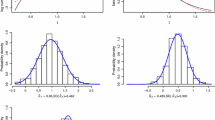Abstract
We consider efficient estimation of regression and association parameters jointly for bivariate current status data with the marginal proportional hazards model. Current status data occur in many fields including demographical studies and tumorigenicity experiments and several approaches have been proposed for regression analysis of univariate current status data. We discuss bivariate current status data and propose an efficient score estimation approach for the problem. In the approach, the copula model is used for joint survival function with the survival times assumed to follow the proportional hazards model marginally. Simulation studies are performed to evaluate the proposed estimates and suggest that the approach works well in practical situations. A real life data application is provided for illustration.
Similar content being viewed by others
References
Anderson PK and Gill RD (1982). Cox’s regression model for counting processes: a large sample study. Ann Stat 10: 1100–1120
Bickel P, Klaassen C, Ritov Y and Wellner J (1993). Efficient and adaptive estimation for semiparametric models. The Johns Hopkins University Press, Baltimore
Clayton DG (1978). A model for association in bivariate life tables and its application in epidemiological studies of familial tendency in chronic disease incidence. Biometrika 65: 141–151
Cox DR (1972). Regression models and life-table (with discussion). J Roy Stat Soc B 33: 187–220
Ding AA and Wang W (2004). Testing independence for bivariate current status data. J Am Stat Assoc 99: 145–155
Dunson D and Dinse G (2002). Bayesian models for multivariate current status data with informative censoring. Biometrics 58: 79–88
Foutz RV (1977). On the unique consistent solution to the likelihood equations. J Am Stat Assoc 72: 147–148
Genest C and MacKay J (1986). The joy of copulas: bivariate distributions with uniform marginals. Am Stat 4: 280–283
Genest C and Rivest L-P (1993). Statistical inference procedures for bivariate Archimedean copulas. J Am Stat Assoc 88: 1034–1043
Goggins WB and Finkelstein DM (2000). A proportional hazards model for multivariate interval-censored failure time data. Biometrics 56: 940–943
Groeneboom P and Wellner JA (1992). Information bounds and nonparametric maximum likelihood estimation. Birkhäuser, Boston
Hougaard P 2000 Analysis of multivariate survial data. Springer
Huang J (1996). Efficient estimation for the proportional hazards model with interval censoring. Ann Stat 24: 540–568
Huang J and Rossini JA (1997). Sieve estimation for the proportional odds model with interval-censoring. J Am Stat Assoc 92: 960–967
Huard D, Evin G and Favre A-C (2006). Bayesian Copula selection. Comput Stat Data Anal 51: 809–822
Jewell NP, van de Laan M and Lei X (2005). Bivariate current status data with univariate monitoring times. Biometrika 92: 847–862
Keiding N (1991). Age-specific incidence and prevalence: a statistical perspective. J Roy Stat Soc A 154: 371–412
Kim MY and Xue X (2002). The analysis of multivariate interval-censored survival data. Stat Med 21: 3715–3726
Lin DY, Oakes D and Ying Z (1998). Additive hazards regression with current status data. Biometrika 85: 289–298
Martinussen T and Scheike TH (2002). Efficient estimation in additive hazards regression with current status data. Biometrika 89: 649–658
Rossini A and Tsiatis AA (1996). A semiparametric proportional odds regression model for the analysis of current status data. J Am Stat Assoc 91: 713–721
Shih JH and Louis TA (1995). Inference on the association parameter in copula models for bivariate survival data. Biometrics 51: 1384–1399
Sun J (2006) The statistical analysis of interval-censored data. Springer
Sun L, Wang L and Sun J (2006). Estimation of the association for bivariate interval-censored failure time data. Scand J Stat 33: 637–649
Wang W and Ding AA (2000). On assessing the association for bivariate current status data. Biometrika 87: 879–893
Wei LJ, Lin DY and Weissfeld L (1989). Regression analysis of multivariate incomplete failure time data by modeling marginal distributions. J Am Stat Assoc 84: 1065–1073
Author information
Authors and Affiliations
Corresponding author
Rights and permissions
About this article
Cite this article
Wang, L., Sun, J. & Tong, X. Efficient estimation for the proportional hazards model with bivariate current status data. Lifetime Data Anal 14, 134–153 (2008). https://doi.org/10.1007/s10985-007-9058-9
Received:
Accepted:
Published:
Issue Date:
DOI: https://doi.org/10.1007/s10985-007-9058-9




